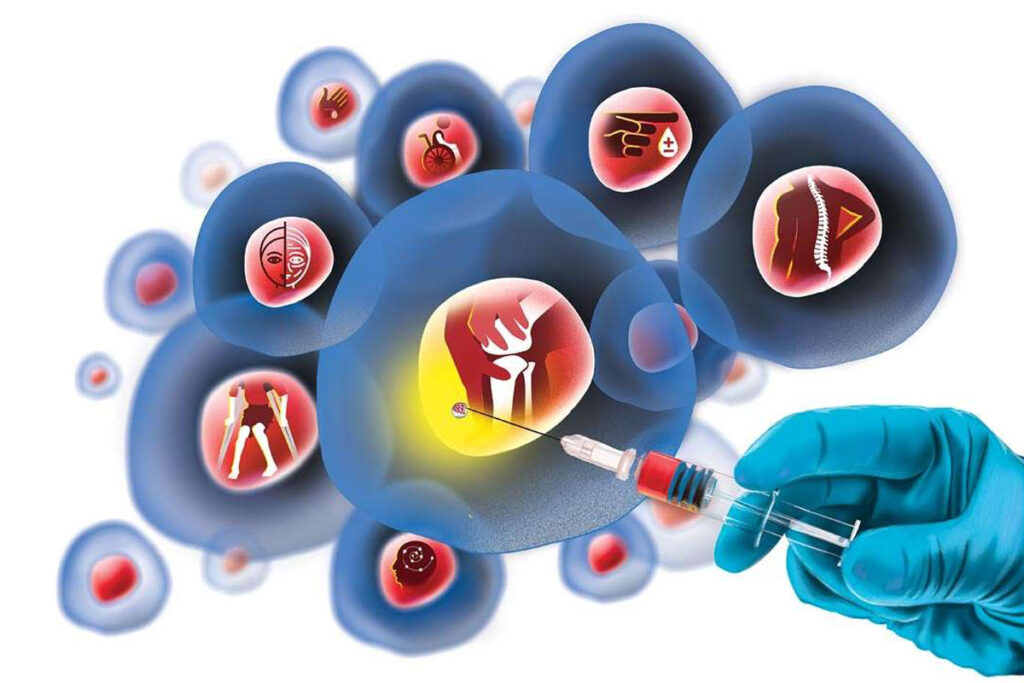
Chronic wounds impose a significant burden on patients as well as the healthcare system. It is increasing day by day. Current wound healing modalities cannot wholly cure chronic wounds. Researchers are working day and night to find novel methods which have a better outcome. Stem cell therapy is one of the novel treatment modalities used by hospitals to treat chronic wounds. Stem cell therapy is used in many clinics for chronic wound healing. Compared to the existing hospital-based techniques of treating chronic wounds, stem cells have a better outcome because of their regenerative property.
Wound Healing:
Skin is the largest organ of the body. Skin is the body’s first line of immune and physical defense. A break in the integrity of the skin leads to injury and wound formation. Skin wound healing is a multi-step process that involves many cells and a cascade of events.
Types of skin wounds include lacerations, abrasions, punctures, surgical wounds, ulcers, burns, and burn-like wounds. Cutaneous wounds can be broadly classified into two categories;
- An acute wound is a wound that heals in less than three months.
- Chronic wounds are wounds that do not heal for more than three months.
Chronic wounds result from an interruption in the cascade of the normal healing mechanism. There are four main phases of wound healing.
- Hemostasis
- Inflammation
- Proliferation
- Remodeling
Mechanism of Wound Healing:
After an acute injury, platelets from the blood come to stop bleeding resulting in homeostasis. In the meantime, leukocytes are recruited and start an inflammatory phase. Inflammation protects the wound from bacterial infection. As inflammation settles down, epithelial cells begin a proliferative phase. In the final remodeling phase, the extracellular is constantly reconstructed. Finally, various changes occur in collagen to strengthen skin integrity.

Chronic Wounds:
Chronic wounds are non-healing wounds. Chronic wounds occur due to disruption in any phase of normal skin recovery after injury. Following are the most common examples of chronic wounds
- Diabetic Ulcers
- Pressure Sores
- Arteriovenous Ulcers
Diabetes, autoimmune diseases, poor hygiene, and malnutrition main predisposing factors in non-healing chronic wounds. Chronic wounds not only lower the living quality of patients but also impose a huge economic burden on society. In addition, the poor appearance of wounds and disability of movements both bother patients.
Management of chronic wounds by hospitals:
In hospitals, doctors are using a variety of therapies and treatment strategies for chronic wounds. Following are the current conventional treatment options used by hospitals
- Application of wound dressing
- Over-the-counter use of antibiotics and painkillers.
- Debridement of necrotic tissue
- Skin grafting
These treatment options mentioned above most of the time cannot heal a chronic wound. They have several limitations and adverse effects.
- Repeated infection
- Stomach upset due to over-the-counter use of NSAIDs
- Gangrene
- Cellulitis
- Sometimes amputation has to be done to save the life of a patient.
Because of the failure of conventional treatments, new methods for healing chronic wounds are extensively used in clinical trials. Following are the new treatment modalities used by hospitals for chronic wound healing
- Electrical stimulation
- Shock wave therapy
- Stem cell treatment
All these new treatment options are in clinical trials. Among them, stem cell treatments are being extensively used in various hospitals. Since stem cells can regenerate, they have more favorable and prospective effects on the healing of chronic wounds.

Stem cell treatment for chronic wounds:
Stem cells are defined by their ability to regenerate and differentiate into multiple cell types. Stem cell regenerative and reparative properties play an important role in every phase of wound healing. Chronic wounds are often associated with impaired stem cell function. Stem cells can either be autologous (derived from the patient’s own body) or they can be allogeneic (derived from the donor body).
The most common types of stem cells used for chronic wound healing are autologous. Following stem cells show successful results in clinical trials in chronic wound healing
- Adipose-derived stem cells
- Induced pluripotent stem cells
- Bone Marrow derived mesenchymal stem cell
Role of stem cells in chronic wound healing:
Mostly adult stem cells derived from patients are injected into chronic non-healing wounds. Stem cells act at every stage of wound healing to improve the condition of chronic wounds.
- Stem cell treatment can improve blood vessel formation. Resulting in increased vascularization and healing in an anti-angiogenic environment of chronic wounds.
- Stem cell treatment reduces inflammation at the site of chronic wounds. Reduction of inflammation modifies chronic wound environment and promotes healing.
- Stem cell treatment results in enhanced fibrosis and tissue recognition. This is crucial to prevent the recurrence and reversion of chronic wounds.
- Stem cell treatment also reduces scar formation.
Stem cells thus by modulating inflammatory response and vascularization promote chronic wound healing.
Conclusion:
Due to its distinct characteristics, stem cell therapy has a better outcome for chronic wound healing than traditional treatment approaches. We hope in the future, the use of stem cell treatment for chronic wound healing can lower the financial burden on hospitals and society.


